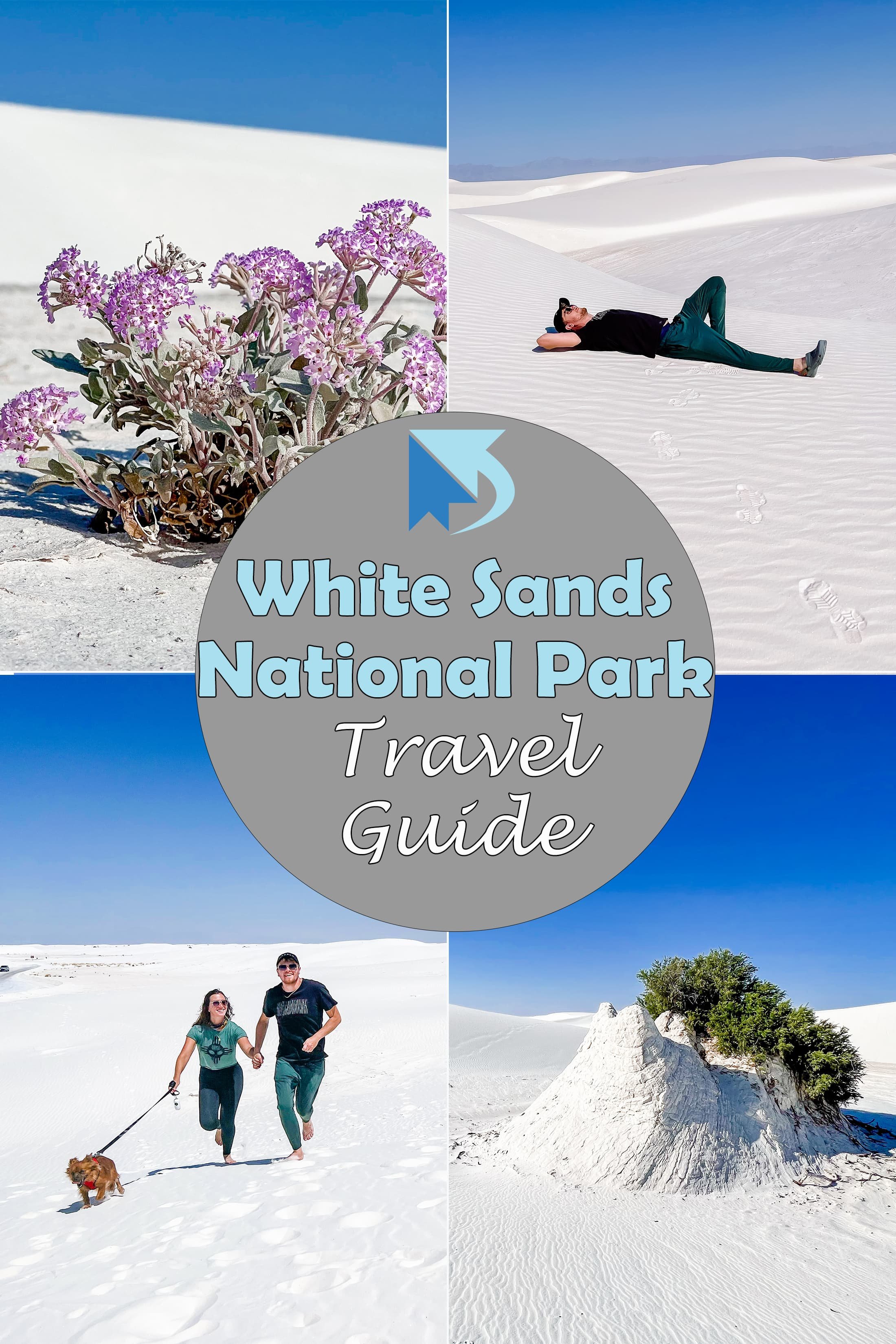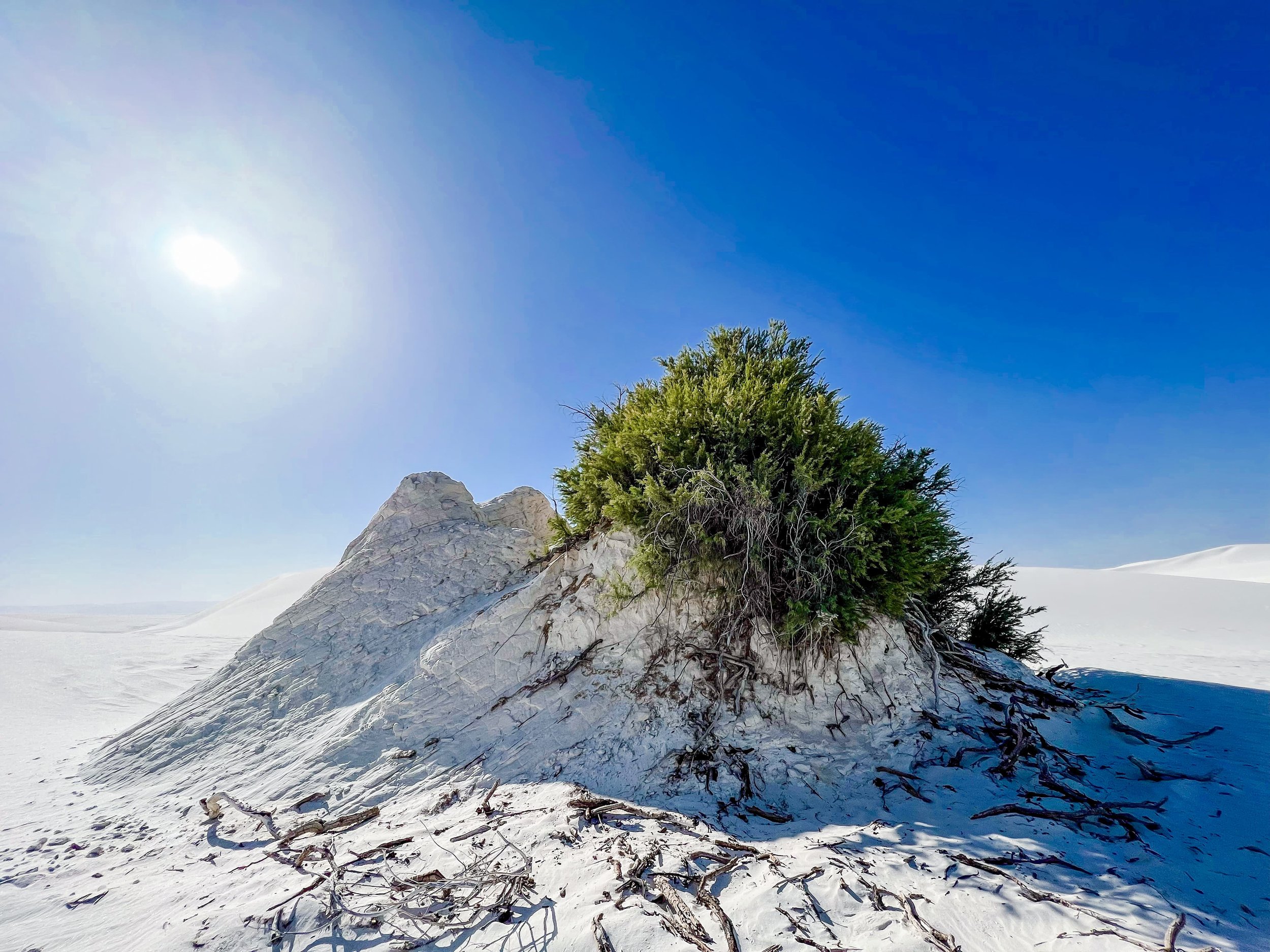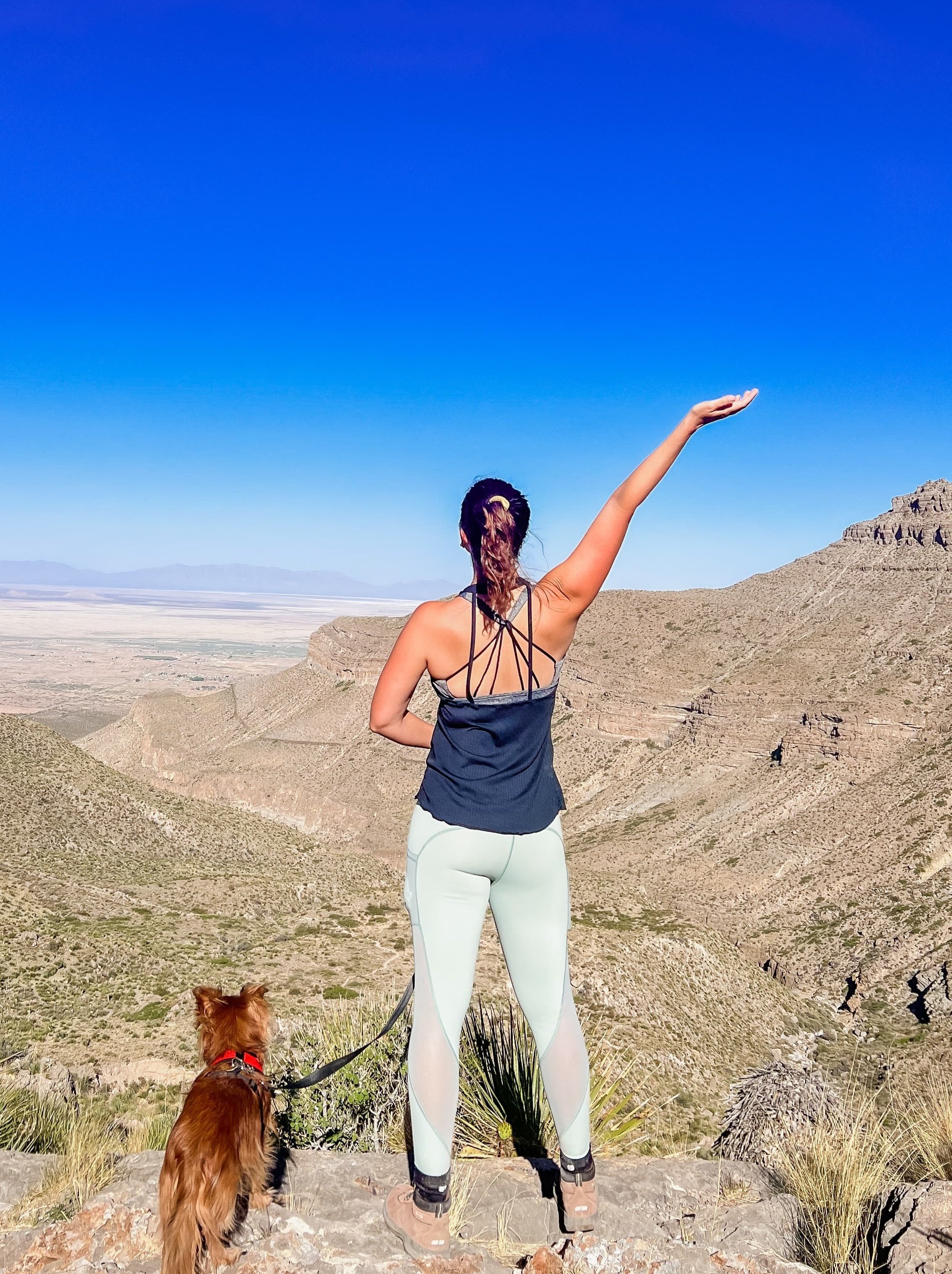Discover Your Ultimate Guide to Visiting White Sands National Park
Tips for ensuring you will LOVE your next visit to White Sands National Park.
This post may contain affiliate links where I earn a small commission when you make a purchase using the links at no additional cost to you.
📍- Alamogordo, New Mexico
Where in the world can you wander through dunes of powder-soft sand, sparkling like brilliant white diamonds as far as the eye can see? Surely, such a place must exist within the arid land of the Egyptian Sinai desert, or perhaps along the dunes of Arabia, just outside of the exotic city of Dubai. In fact, the largest basin of stark-white, fine crystalline, gypsum sand is found in humble New Mexico, USA.
White Sands National Park is one of the most striking locations in the United States. Here, over 200 square miles of dazzlingly white sand shifts with the changing wind to create a dynamic and ever-changing landscape.
This national park has been on my bucket list since I first saw it appear on my television screen as a child, its unique scenery being used as a backdrop for notable Hollywood productions such as “Star Wars: A New Hope”. My desire to explore this otherworldly terrain led us to the small town of Alamogordo where the national park is located. Now, after thoroughly scouting the park, and playing in the sand as much as my body could handle, we have to say that this location has been one of our all-time favorite stops throughout our 9 months of RV travel.
Even still, we met many travelers along the way who tried their best to persuade us to ditch this destination altogether. We heard a lot of statements like, “Once you’ve seen one dune, you’ve seen them all”. As White Sands enthusiasts, we have to say that we couldn’t disagree more! We fell in love with this national park during our visit, something we owe to some tips and tricks that we followed closely. So, if you are interested in visiting White Sands National Park, and you want to LOVE your time there, keep reading to learn about our top tips for visiting the park.
One of our favorite plants we found at the park was skunkbrush sumac, a beautiful example of life surviving in a dry, desert landscape.
But first, how did the gypsum sand get here?
The gypsum sand which covers White Sands today is a remnant of an ancient ocean. 250 million years ago, back when the earth’s continents were attached in one mega continent known as Pangea, the shallow but massive Permian Sea covered the majority of what is now the southern United States, including New Mexico.
Between 70 and 30 million years ago, the earth’s tectonic plates began to shift, first colliding to create large mountain ranges including the famously known Rockies, and then separating to create basins along the plate’s fault lines. Among these newly created basins was the Tularosa Basin, of which White Sands National Park is a part, surrounded by the Eastern San Andres Mountains and the Western Sacramento Mountains. Sediment-rich waters from the Permian Sea became trapped here, forming a lake that was highly concentrated in gypsum.
As the climate began to warm from its last ice age, and gypsum-dense icebergs began to melt and fall down the San Andres Mountains, the area of White Sands became a natural reservoir, which then transitioned into a basin full of gypsum when the water evaporated from the area. Over the process of 10,000 years, strong winds began to blow the sediment, breaking it down into fine gypsum crystals and polishing the crystals to become the dazzling white sand grains that form these famous dunes today. Contemporary statistics say that nearly 800,000 visitors flock to these dunes every year.
Tips for Visiting White Sands National Park - and loving it
Research the seasons
Every season has its own set of benefits and dangers when visiting White Sands National Park, so it is important that you make yourself aware of these before you make the trek to Alamogordo.
Summers can be oppressively hot with the daytime temperatures approaching 100 °F. Monsoon season lasts from early July through late September, bringing heavy bouts of rain and an increased risk for thunderstorms. Winters are cold during the nights and could make camping in the park’s backcountry unpleasant. Spring is the windiest season, with strong gusts forcing large quantities of sand into the air and increasing the danger of hikers becoming disoriented.
While there is debate over when the best time to visit the park is, we visited in late April, when the weather was warm during the day and cool at night. We monitored the forecast for windy days, choosing a calm day to explore the park and had wonderful weather for the occasion.
If this picture doesn’t exude pure joy and excitement over being at White Sands National Park, I don’t know what does!
Check for closures
White Sands National Park’s boundaries also encompass the White Sands Missile Range which regularly conducts missile tests near the area. For this reason, Dunes Drive, which is the only road leading through the park, can occasionally be closed to the public. Be sure to monitor any scheduled road closures here so that you’re not surprised by any unexpected delays to your visit. These closures are typically known two weeks in advance of the event but can occasionally occur with only 24 hours’ notice.
Stay hydrated
If you’ve successfully made it into the park, you will quickly realize that the conditions at White Sands can be a bit unforgiving. With no trees and little vegetation, there is nowhere to hide from the hot desert sun. No matter what your chosen activity is for the day, you’ll soon find yourself sweating and in need of refreshment. The golden rule at White Sands National Park is to pack more water than you think you need. The park recommends one gallon of water, per person, per day, with additional supplies needed for any pets you may be bringing along.
If you happen to show up to the park unprepared, something we are all guilty of from time to time, you can find water at the visitor’s center by the park entrance. Just be aware that there is no water available within the dunes or at any of the picnic areas.
If my mention of furry friends on the trail didn’t make it clear, let me be the first to tell you that dogs are indeed welcome at White Sands National Park. Be sure to pack them a bowl and some extra water.
Ditch the sleds
One of the most popular activities at White Sands National Park is sledding down these pristine sand dunes. Now, this tip may be controversial, but we have to say it. If you want to fall in love with this park, don’t even bother with the sleds. While gypsum sand might look like snow, it is not slippery like it at all. You’ll want to heavily wax the bottom of your slide for the chance of not getting stuck halfway down a dune. The steepest dunes, and also the ones which would be the best to sled down, are located deep within the dune field, meaning you’ll likely be dragging the sled around on your back for hours as you search for a sledding opportunity.
The park sells sleds for around $20 at the visitor’s center, a hefty price for a plastic toy if you ask me. While you can sometimes find the toys for much less at big box stores in Alamogordo, they frequently sell out. During our trip, we drove by several sleds that had been abandoned by guests the night before. So, if you really want to try sledding, I would simply pick one of these bad boys off the curb. Better yet, try out our next tip for a White Sands Activity that will really knock your socks off.
Take a Hike
Hey, you. Take a hike! No, I’m not being sassy, although I have been known to do that from time to time. I’m telling you that the hike we took through White Sands National Park was one of our favorite hikes we have ever taken!
White Sands offers several hikes which can accommodate almost every skill level and can be perused here for more information. Briefly, the Interdune Boardwalk and Playa Trail are half-mile, easy, and family-friendly hikes that take you on a stroll through the dunes while teaching you about the geology and wildlife within the park. The Dune Life Nature Trail and the Backcountry Camping Trail are both moderately ranked, totaling one mile and two miles in length, respectively. Both of these require climbing dunes to complete.
The star of the park, though, is the Alkali Flat Trail, a hike titled with a misnomer because this path is NOT flat! This hike is a strenuous, 5-mile round trip experience that leads you through the heart of the dunes. What makes this hike spectacular is that you are treated to a fresh, yet equally stunning view with every crest of a new sand dune, and with the wind ever-changing the landscape, you are guaranteed never to see the same view twice. While this trail shouldn’t be done on a whim, if you are able-bodied, and come prepared with plenty of water, food, and sun protection, you should be just fine and enjoy a lovely time out in a unique natural landscape.
A very kind stranger took this picture of the three of us while we were walking on the dunes, one that memorializes this fantastic hike.
Start Early
If you plan to spend any significant amount of time in the park, we wholeheartedly recommend that you start your day bright and early. The park opens its gates at 7 a.m., and we suggest you be one of the first people to knock down their door. When we went to the park, rising early allowed us to start our hike at 7:30 in the morning. It was cool enough that day that we had sweatshirts on until halfway through the hike, but the temperature almost reached 90 °F by the time we left.
Climbing sand dunes is more strenuous than you may expect, and heatstroke is one of the greatest risks that threaten visitors in the park. This is why the park does not recommend starting a hike if the temperature is at or above 85 °F (30 °C).
Wear hiking sandals
I told you hiking White Sands National Park would knock your socks off right? Well, I actually meant that both figuratively and literally, because we recommend ditching your socks for White Sands! While you’re at it, ditch those shoes too!
No one likes a shoe full of sand, but that is exactly what you will get if you attempt to explore these dunes with sneakers or hiking boots. Instead, we suggest you opt for hiking sandals. During our hike, I wore my trusty pair of Tevas, and my husband, Drew, wore a pair of all-terrain Crocs with the heal straps securely in place, of course. Wearing Crocs on a 5-mile hike may sound silly, but believe me when I say it is the way to go for this one.
Pack Lunch
While you are playing in the sand at the national park, you are going to work up an appetite and will surely need to refuel your calorie reserve at some point in the day. Luckily, the park supplies a multitude of picnic benches for visitors, each equipped with a sunshade which does an excellent job at creating an oasis for anybody trying to find refuge from the sun. You can either opt to enjoy a home-packed snack or you can opt for a local favorite.
Just a few miles outside of the park is a small, family-run sandwich shop called the Brown Bag Deli. It’s a traditional New York-style deli counter in the middle of New Mexico, and they serve up French bread hoagies that taste like home for this Philadelphia girl. This sandwich shop gets five stars from us at Discovery Detour, and we highly recommend that you give them a try!
Bring an umbrella
If the thought of eating lunch at a standard picnic table tempts you to yawn from boredom, why not opt for a picnic atop the dunes? This wonderful idea was something that we weren’t able to personally partake in because we didn’t bring a beach umbrella. For us, the sun was simply too high in the sky for us to want to venture out from under our sun-protected table. We were tired, hungry, and in need of some cool shade after our hike.
We did, however, stare longingly at those prepared tourists who had planned accordingly, watching as they basked in their umbrella-shaded glory, reigning supreme atop a glorious dune. It’s possible that I may have been delirious from hunger at this point, so perhaps I’m remembering it to be more dramatic than it actually was, but you get the point. Pack a beach umbrella if you want to be the king of a sand mountain for lunch hour.
Lotion Up
While the white color of the sand within this national park is beautiful, consistently cool to the touch, and unique, it also reflects a lot of sunlight. Walking atop the sand dunes puts you at an increased risk for sunburn, and you should dress and plan accordingly. Make sure you have some sort of hat or head covering to keep the sun rays off of your face during the hottest point of the day and apply sunscreen more often than you think you need to. This includes applying a bit of sunscreen to the noses of any furry friends who you may have tagging along on your expedition.
Even though it was getting hot at this point, Drew kept on his long pants, hat, and sunglasses to protect him from the sun. Many even recommend wearing long sleeves.
Appreciate the wildlife
In addition to White Sands National Park having one of the most unique landscapes in the country, it also contains some of the most unique wildlife species as well. While you are exploring this national wonder, take some time to learn about them and explore them. Some of our favorites include the skunkbush sumac, an interesting shrub that grows extremely long roots that allow it to stay in place after the dunes have moved to a different location. The result is a column-like structure that protrudes out of the sandy ground. Sand verbenas are also a personal favorite, being delicate purple flowers that are fast growers, quickly spreading their seed before they become covered by shifting sand.
This is desert verbenas, its striking purple flowers giving a pop of color around in the otherwise colorless plot of land.
Explore the surrounding area
White Sands National Park sits at the eastern boundary of Alamogordo, New Mexico. While Alamogordo is certainly a small town, there are definitely some gems that you should take the time to explore if you have the opportunity to do so. Specifically, we recommend you explore Oliver Lee Memorial State Park, a beautiful park that offers cheap camping and gorgeous views. Within this park is Dog Canyon Trail, a strenuous, 5-mile hike that leads you through a stretch of arid, mountainous terrain in Lincoln National Forest. At points throughout this hike, you will actually be able to look out over the mountain top and see White Sands National Park shining on the horizon.
Here I am after conquering a particularly challenging stretch of Dog Canyon Trail. White Sands is located just beyond the ridge over my left shoulder.
Of course, if you’re looking for a place to enjoy dinner and like Mexican Food, then you should try CJ’s Si Señor Mexican Restaurant. I can personally recommend their chicken enchiladas!
Is White Sands National Park on your bucket list? Maybe you’ve already visited the park and have some amazing tips to share that I may have missed. Be sure to comment down below so that we can inspire future travelers together!
Thank you for joining us at Discovery Detour, where the destination is always unknown.








